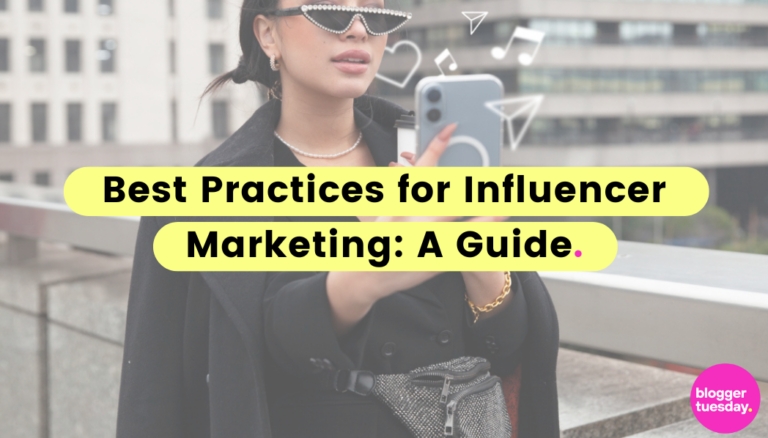Influencer marketing remains one of the most popular marketing trends in the modern era, and it delivers proven results. Some wild statistics from the Digital Marketing Institute demonstrate that 85% of marketers believe influencer marketing helps them acquire new customers, and most businesses quintuple their return on investment.
In other words, if you’re not already working with influencers, now’s the time to start. There’s a lot to consider if you want to do it right, so here’s a breakdown of the best practices for influencer marketing.
Understanding Influencer Marketing Basics
Before we dive headfirst into the nitty-gritty elements of influencer marketing, let’s talk about the basics.
What is it, and how does it work?
On the simplest level, influencer marketing is all about working with individuals who have a relatively powerful online presence. They possess an “influence” over their audience, and the goal is to use this to promote your brand.
You’ll pay an influencer to produce content, and they basically advertise your brand, service, or products to their core demographic. In other words, it’s like you’re piggybacking on all the hard work they did to establish an online presence.
Identifying the Right Influencers for Your Brand
That brings us to the biggest question: how do you find the right influencers for your brand?
Your initial response is to search for people with the largest number of followers. It’s a common misconception to assume that having loads of followers means they have the most amount of influence.
That’s not strictly true.
The right influencers for your brand must:
- Align with your brand ethos and goals
- Cater to the same market/audience as your brand
- Are popular on networks that work for you
- Fit within your budget
Working with an influencer who has a million Instagram followers is pointless if their target audience doesn’t fit with your brand. You’re basically wasting a lot of money on a campaign that won’t deliver results.
Brands are encouraged to look for micro influencers – people with between 10,000 to 100,000 followers and a very niche audience – because they offer the best value for money and results. Pick some who meet your brand goals and cater to your market if you want influencer marketing to be successful.
Crafting an Effective Influencer Brief
When it’s time to partner with influencers, you need to craft a brief to send out to prospective candidates. This brief serves a simple purpose: it explains what you want the influencer to do and sets some of the key ground rules for your partnership.
The best influencer briefs will comprise:
- An opening section on your brand, explaining your core purpose and values, so they know how to align with it.
- An overview of the specific campaign the influencer will be working on. Include information on their main objectives and anything else that may be important, such as certain hashtags to use in their content.
- Key deliverables you expect from the influencer. This includes all of the following:
- Social media channels you want them to use
- The format of any content they produce
- The type of content you want them to make – e.g., blogs, videos, reels, etc.
- A timeline stipulating when you expect them to post content
- How much content they’re expected to produce for your brand
- Some general guidelines for how they need to produce content. This will involve things like the tone of voice, any subjects to explicitly avoid, CTAs, and so on.
- Information on your content review process, which explains how you look over their content and decide if it’s suitable or not.
- Information on compensation and payments to tell the influencer how much you’ll charge. You’re also going to explain the payment dates and any extra perks they may receive. E.g., A bonus if you generate x amount of sales or signups from their content.
This entire brief needs to be professional, and the idea is that any influencer can read through it and be 100% onboard with what you want from them, and what they get from the partnership. It’s one of those situations where you send over the brief and ask if they have any questions – if they say no, then you know you’ve written a killer brief!
Setting Clear Goals and KPIs for Your Campaign
One of the key influencer marketing best practices is to always establish goals and KPIs before embarking on any campaigns. As noted above, this should form part of your influencer brief – it helps influencers understand what’s expected of them when they see your key goals and objectives.
Your goals are what you want to get out of the influencer campaign, and the KPIs are certain metrics that help you see if you’re achieving these goals.
Some examples include:
- Improving brand awareness – You want influencers to make people more aware of your brand, which means you’ll track things like new followers coming off the back of your influencer marketing campaigns, or an increase in searches for your brand name.
- Increasing website traffic – Some campaigns have the simple goal of using influencers to drive traffic to a website. This is easily viewed when you track your web traffic metrics after or during a campaign.
- Increasing product sales – Many brands like to partner with influencers to promote certain products or services. As such, it’s easy to track this goal by viewing sales figures or tracking affiliate links from influencers.
- Driving leads – For some brands, it’s all about generating more leads. This is reflected in getting people to follow your social channels, sign up for mailing lists, and so on.
You can think about many other goals and KPIs for your campaign, but the underlying focus is to be clear when setting them. Know what you want to get out of influencer marketing before you invest in it.
Legal Considerations in Influencer Partnerships
A lot of brands don’t realise that partnering with influencers comes with some legal considerations. Primarily, you need to make it crystal clear to everyone that you’re paying the influencer to promote your brand. They have to display this in a way that’s easy for their followers to see, or you could both land in legal trouble.
LegalVision also underlines the importance of complying with any relevant legal bodies, such as the Competition and Markets Authority (CMA), to be sure you follow all the necessary advertising rules. You can’t mislead consumers, which is something you must get across when creating your influencer brief and reviewing their content. If an influencer makes untrue claims about your brand, products, or services, then you’ll land in hot water.
One other big thing to consider is the avoidance of any copyright infringement. You must check an influencer’s content before allowing them to publish it so they don’t accidentally include copyrighted work. The most common case is an influencer including copyrighted background music in videos of reels.
Measuring the Success of Influencer Campaigns
How do you determine if an influencer campaign is successful or not?
Well, it goes back to your goals and KPIs. If you’re achieving your main goals as a direct result of an influencer partnership, then that means it was a success. This can sometimes be hard to track, so you’ll rely on analytics software to measure “invisible” metrics like web traffic, brand mentions, brand searches, and so on.
The good news is that it’s normally very easy to track an influencer campaign because you notice obvious correlations. If you normally only gain 10 followers a month, but suddenly start gaining 50 a week after an influencer campaign goes live, then it’s fairly clear that your campaign helped.
Plus, you often give influencers special affiliate links to direct users to your website. These links are easy to track, letting you see how much traffic came as a result of your campaign, or even how many direct/indirect sales the influencer was responsible for.
Leveraging Influencer Content for Long-Term Gains
Any brand can find an influencer and strike up a short-term partnership to see some impressive results. However, the best way to leverage influencer content is by viewing it through a long-term lens.
You want to find influencers who consistently deliver results and can work with you across many months or years. Establish long-term partnerships where the influencer is a brand ambassador with a constant affiliate link or discount code for your brand, then write in their contract that they need to create x amount of promotional posts per week/month to advertise your brand.
Or, work with the same influencers whenever you have new things to promote. Many brands choose to set up influencer campaigns for new products or services, giving them a better launchpad.
The bottom line is that you shouldn’t view this as a “one and done” thing – influencer marketing works best when you continue it over a longer period.
Ready to Boost Your Brand? Start Your Influencer Partnership Today!
Influencer marketing clearly brings loads of benefits to brands of all sizes, so why don’t you get started today? Sign up as a brand on Blogger Tuesday and we’ll find you the best blogging influencers to help you create masterful content.


